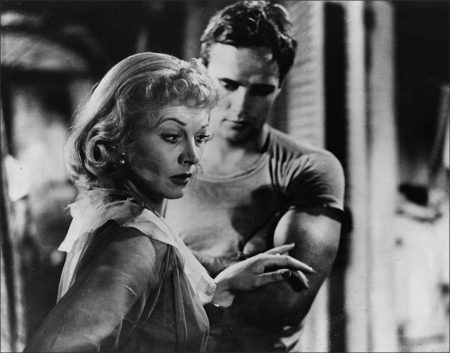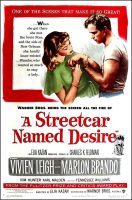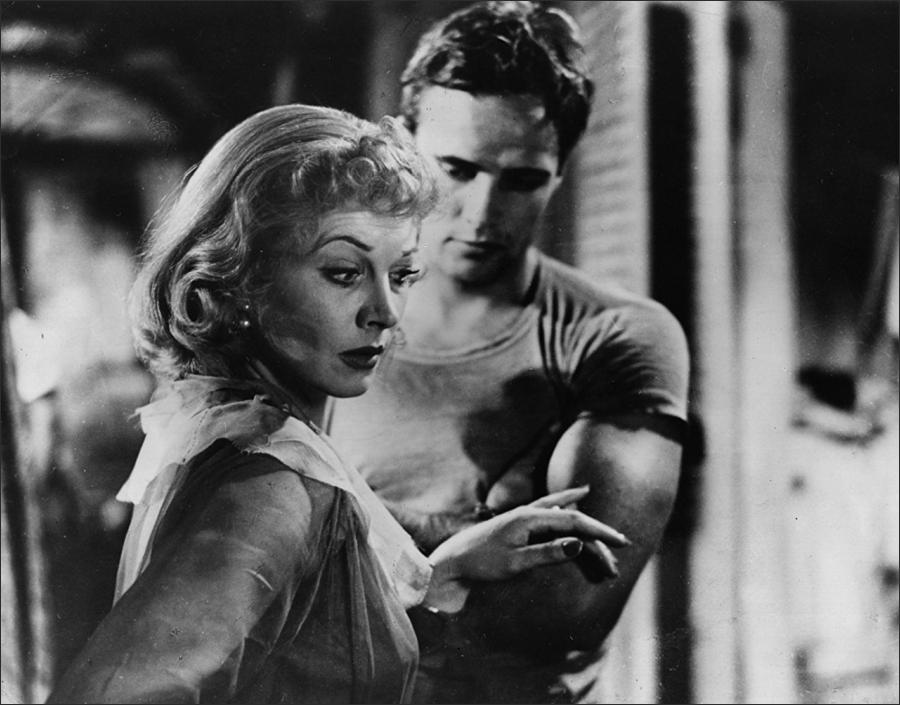Tagline: …Blanche, who wanted so much to stay a lady…
A Streetcar Named Desire movie storyline. Blanche DuBois, a high school English teacher with an aristocratic background from Auriol, Mississippi, decides to move to live with her sister and brother-in-law, Stella and Stanley Kowalski, in New Orleans after creditors take over the family property, Belle Reve. Blanche has also decided to take a break from teaching as she states the situation has frayed her nerves.
Knowing nothing about Stanley or the Kowalskis’ lives, Blanche is shocked to find that they live in a cramped and run down ground floor apartment – which she proceeds to beautify by putting shades over the open light bulbs to soften the lighting – and that Stanley is not the gentleman that she is used to in men. As such, Blanche and Stanley have an antagonistic relationship from the start. Blanche finds that Stanley’s hyper-masculinity, which often displays itself in physical outbursts, is common, coarse and vulgar, being common which in turn is what attracted Stella to him. Beyond finding Blanche’s delicate hoidy-toidy act as putting on airs, Stanley, a plant worker, believes she may really have sold Belle Reve and is withholding Stella’s fair share of the proceeds from them.
What further affects the relationship between the three is that Stella is in the early stage of pregnancy with her and Stanley’s first child. Soon after her arrival at the Kowalskis, Blanche starts to date Mitch, one of Stanley’s friends and coworkers who is a little softer around the edges than most of Stanley’s friends. Mitch does not hide the fact that he is looking in general to get married because of a personal issue, he wanting Blanche ultimately to be his wife.
Mitch is somewhat unaware that Blanche has somewhat controlled their courtship to put herself in the best possible light, both figuratively and literally. But in Stanley’s quest to find out the truth about Belle Reve and Blanche’s life in Auriol, the interrelationships between Stanley, Blanche, Stella and Mitch may be irrevocably affected, with any revelation about that life which may further destroy what’s left of Blanche’s already damaged mental state.
About the Film
A Streetcar Named Desire (1951) is a subversive, steamy film classic that was adapted from Tennessee Williams’ 1947 Pulitzer Prize-winning play (his first) of the same name. [Early working titles for the play included The Moth, Blanche’s Chair on the Moon, and The Poker Night.] Playwright Williams adapted his own play for the screen version.
This film masterpiece was directed by independent director Elia Kazan (his first piece of work with Williams), a socially-conscious director who insisted that the film be true to the play (that he had also directed on Broadway). However, it was opened up to include places only briefly mentioned or non-existent in the play, such as the bowling alley, the pier of a dance casino, and the machine factory.
The electrifying film tells the feverish story of the pathetic mental and emotional demise of a determined, yet fragile, repressed and delicate Southern lady (Blanche) born to a once-wealthy family of Mississippi planters. Her impoverished, tragic downfall in the squalid, cramped and tawdry French Quarter one-bedroom apartment of her married sister (Stella) and animalistic brother-in-law (Stanley) is at the hands of savage, brutal forces in modern society. In her search for refuge, she finds that her sister lives (approvingly) with drunkenness, violence, lust, and ignorance.
The visceral film, considered controversial, decadent, and “morally repugnant” challenged the regulatory Production Code’s censors (and the Legion of Decency) with its bold adult drama and sexual subjects (insanity, rape, domestic violence, homosexuality, sexual obsession, and female promiscuity or nymphomania). Ultimately, it signaled the weakening of Hollywood censorship (and groups such as the Catholic Legion of Decency), although a number of scenes were excised, and new dialogue was written. And the Production Code insisted that Stanley be punished for the rape by the loss of his wife’s love at the film’s conclusion.
A Streetcar Named Desire is a 1951 American drama film, adapted from Tennessee Williams’s Pulitzer Prize-winning 1947 play of the same name. It tells the story of a southern belle, Blanche DuBois, who, after encountering a series of personal losses, leaves her aristocratic background seeking refuge with her sister and brother-in-law in a dilapidated New Orleans tenement. The Broadway production and cast was converted to film with several changes.
Tennessee Williams collaborated with Oscar Saul and Elia Kazan on the screenplay. Kazan, who directed the Broadway stage production, also directed the black and white film. Marlon Brando, Kim Hunter, and Karl Malden were all cast in their original Broadway roles. Although Jessica Tandy originated the role of Blanche DuBois on Broadway, Vivien Leigh, who had appeared in the London theatre production, was cast in the film adaptation for her star power.
Upon release of the film, Marlon Brando, virtually unknown at the time of the play’s casting, rose to prominence as a major Hollywood film star. The film marked the first of Marlon Brando’s four consecutive Academy Award nominations for Best Actor and earned an estimated $4,250,000 at the US and Canadian box office in 1951, making it the fifth biggest hit of the year. In 1999, A Streetcar Named Desire was selected for preservation in the United States National Film Registry by the Library of Congress as being “culturally, historically, or aesthetically significant”.
A Streetcar Named Desire (1951)
Directed by: Elia Kazan
Starring: Vivien Leigh, Marlon Brando, Kim Hunter, Karl Malden, Rudy Bond, Nick Dennis, Peg Hillias, Wright King, Richard Garrick, Ann Dere, Edna Thomas, Mickey Kuhn, Marietta Canty, Chester Jones
Screenplay by: Tennessee Williams
Production Design by:
Cinematography by: Harry Stradling Sr.
Film Editing by: David Weisbart
Costume Design by:
Set Decoration by: George James Hopkins
Art Direction by: Richard Day, Bertram Tuttle
Music by: Alex North
MPAA Rating: PG for thematic elements.
Distributed by: Warner Bros. Pictures
Release Date: September 18, 1951
Views: 274





